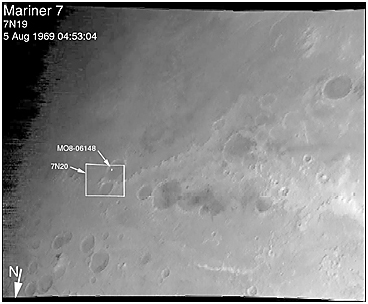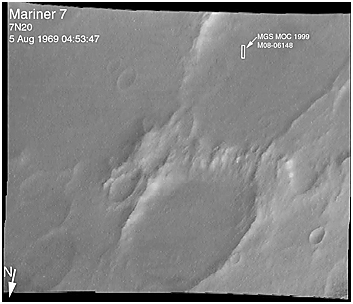

MGS MOC Release No. MOC2-209-supplement, 2 March 2000
 Smaller (125 KByte) Full-Resolution (235 KByte) Full-Resolution, no labels (220 KByte)
|
 Smaller (135 KByte) Full-Resolution (265 KByte) Full-Resolution, no labels (255 KByte)
|
The Mariner Mars 1969 (MM69) Television Subsystem (TVS) cameras used
vidicons with frame dimensions of 704 lines of 945 pixels.
There were two cameras per spacecraft: a wide-angle or A camera with
a 9-degree field of view (FOV), and a narrow-angle or B camera with
a 0.9-degree FOV.
Because digital tape recorder technology was in its infancy, the images were stored using a hybrid digital/analog scheme. Every seventh pixel was digitized within the TVS to eight-bit precision, and then the low-order six bits of each pixel was stored on a digital tape recorder; this was called the Digital Video (DV). Every twenty-eighth pixel was digitized to 8 bits and its middle-order six bits were converted back to analog, combined with the full-resolution analog pixel data, and recorded on an analog tape recorder. Also included every 17.5 lines were the high-order two bits of a single pixel as a coarse absolute level reference. These data were called Composite Analog Video, or CAV. Prior to recording, the full-resolution analog data were sent through a Automatic Gain Control (AGC) circuit and a non-linear transfer function (known as the "cuber") that tried to preserve maximum scene content, but which removed the DC reference of the signal. On analog playback, the analog signal was digitized to six bits for transmission.
Reconstruction on the ground used both DV and CAV to form the final image, although reconstruction could be done with CAV alone if DV was not available. Apparently some degree of manual interaction was required in some cases for this to work well.
There is an amusing quote from the Final Project Report:
"Although the analog record technique allowed the storage of more data (at a high reproduced error, however) than could have been stored digitally on the same length of tape, this method should be avoided on all future missions because of the problems encountered on the 1969 program. Any information to be transmitted from the spacecraft should be converted to a digital format as early as possible in the information channel."
The system also had what was called Automatic Aperture Control (AAC), although it only controlled the selection between two different exposure times and four different gain states. This was to be done on a frame-by-frame basis for both A and B cameras, based on the image statistics from a portion of the previous A frame. AAC was only to be used in near-encounter mode, when the planet filled the FOV of both A and B cameras. In far-encounter mode, AAC was disabled and the system operated at a fixed gain and exposure time.
Due to a wiring error (the wrong portion of the image was used to gather statistics), AAC could not be used in actual practice and was disabled during the encounters.
Malin Space Science Systems and the California Institute of Technology built the MOC using spare hardware from the Mars Observer mission. MSSS operates the camera from its facilities in San Diego, CA. The Jet Propulsion Laboratory's Mars Surveyor Operations Project operates the Mars Global Surveyor spacecraft with its industrial partner, Lockheed Martin Astronautics, from facilities in Pasadena, CA and Denver, CO.